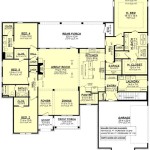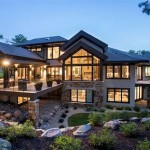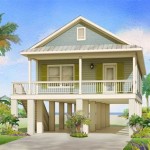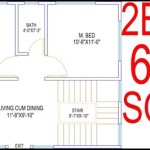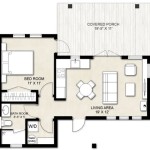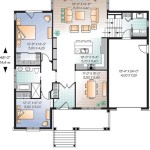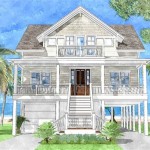Exterior house plans are the blueprints that outline the outward appearance and structural elements of a house. They serve as a visual guide for architects, contractors, and homeowners, providing detailed specifications for the exterior design, materials, and overall aesthetics of a building. These plans typically include elevations, floor plans, and sections that illustrate the house’s external features, such as the roofline, windows, doors, porches, and any other architectural details.
Exterior house plans are essential for visualizing the finished product and ensuring that the design aligns with the homeowner’s vision. They facilitate communication between architects and contractors, allowing for accurate construction and the avoidance of costly errors. Moreover, these plans help homeowners make informed decisions about their home’s exterior, enabling them to customize its appearance, optimize its functionality, and create a cohesive and visually appealing dwelling.
In this article, we will delve deeper into the various components of exterior house plans, exploring the key elements that contribute to the design and aesthetics of a home. We will discuss considerations such as architectural styles, materials, and landscaping, providing insights into how these factors influence the overall appearance and curb appeal of a property.
Exterior house plans serve as a comprehensive guide to a home’s external design. Here are eight key points to consider:
- Architectural Style
- Roofline and Shape
- Exterior Materials
- Windows and Doors
- Porches and Patios
- Exterior Lighting
- Landscaping and Hardscaping
- Curb Appeal
These elements collectively determine the overall appearance, functionality, and aesthetic appeal of a house.
Architectural Style
Architectural style refers to the distinctive characteristics and design elements that define the overall appearance of a house. It encompasses factors such as the shape and pitch of the roof, the type of siding and trim, the placement of windows and doors, and the use of decorative accents. The choice of architectural style can significantly impact the curb appeal and overall aesthetic of a home.
- Traditional Style: Traditional architectural styles, such as Colonial, Victorian, and Craftsman, are characterized by symmetrical facades, pitched roofs, and decorative details. They often feature columns, shutters, and elaborate trim work. Traditional homes exude a sense of classic elegance and timeless appeal.
- Modern Style: Modern architectural styles, such as Mid-Century Modern and Contemporary, emphasize clean lines, geometric shapes, and open floor plans. They often incorporate large windows, balconies, and cantilevered roofs. Modern homes are known for their sleek and sophisticated appearance.
- Rustic Style: Rustic architectural styles, such as Log Cabin and Adirondack, draw inspiration from natural materials and elements. They often feature wood siding, stone accents, and exposed beams. Rustic homes convey a sense of warmth and coziness.
- Mediterranean Style: Mediterranean architectural styles, such as Spanish Colonial and Italian Renaissance, evoke the charm and beauty of the Mediterranean region. They typically feature stucco walls, terracotta roofs, wrought iron balconies, and arched doorways. Mediterranean homes create a warm and inviting atmosphere.
The choice of architectural style should align with the homeowner’s personal preferences and the surrounding environment. It is important to consider the climate, the size and shape of the lot, and the desired functionality of the home when selecting an architectural style.
Roofline and Shape
The roofline and shape significantly influence the overall appearance and functionality of a house. Different rooflines and shapes can create distinct architectural styles and impact the home’s interior and exterior spaces.
- Gable Roof: Gable roofs are the most common type of roofline, featuring two sloping sides that meet at a ridge. They provide ample attic space and allow for easy drainage of rainwater. Gable roofs can complement a variety of architectural styles, from traditional to modern.
- Hip Roof: Hip roofs have four sloping sides that meet at a central point, forming a pyramid shape. They are known for their durability and resistance to high winds. Hip roofs often create a more contemporary and sleek look.
- Gambrel Roof: Gambrel roofs have two sloping sides on each end, with a flatter slope at the bottom and a steeper slope at the top. They are commonly found in Dutch Colonial and American Colonial architectural styles. Gambrel roofs provide additional headroom and storage space in the attic.
- Mansard Roof: Mansard roofs have four sloping sides, with the lower slopes being steeper than the upper slopes. They originated in France and are often associated with Second Empire and Victorian architectural styles. Mansard roofs create a distinctive and elegant appearance.
The choice of roofline and shape should consider factors such as the architectural style of the house, the climate, and the desired interior and exterior spaces. A well-designed roofline can enhance the home’s visual appeal, functionality, and overall value.
Exterior Materials
The choice of exterior materials significantly impacts the durability, aesthetic appeal, and overall performance of a house. Different materials offer unique advantages and disadvantages, and their selection should be carefully considered based on factors such as climate, budget, and desired maintenance level.
- Wood: Wood is a classic exterior material that provides warmth and natural beauty. It is available in various species, each with its own unique grain patterns and color variations. Wood siding can be painted or stained to achieve a desired look and protect it from the elements. However, wood requires regular maintenance to prevent rot, decay, and insect damage.
- Brick: Brick is a durable and long-lasting exterior material that is resistant to fire, insects, and rot. It is available in a wide range of colors and textures, allowing for a variety of design options. Brick exteriors are relatively low-maintenance, but they can be expensive to install and repair.
- Stucco: Stucco is a cement-based exterior material that is applied wet and hardens to a durable finish. It is often used in Mediterranean and Spanish Colonial architectural styles. Stucco is versatile and can be molded into various shapes and textures. However, it can be susceptible to cracking and requires periodic maintenance.
- Vinyl: Vinyl is a low-maintenance and affordable exterior material that is available in a wide range of colors and styles. It is resistant to fading, moisture, and insects. Vinyl siding is easy to install and can mimic the look of more expensive materials, such as wood or stone. However, it can be susceptible to damage from high winds and extreme temperatures.
When selecting exterior materials, it is important to consider their durability, maintenance requirements, aesthetic appeal, and cost. The choice of materials should complement the architectural style of the house and enhance its overall functionality and curb appeal.
Windows and Doors
Windows and doors are essential elements of exterior house plans, providing natural light, ventilation, and access to the outdoors. Their design, placement, and materials can significantly impact the home’s aesthetic appeal, energy efficiency, and overall functionality.
- Style and Design: The style and design of windows and doors should complement the architectural style of the house. Traditional homes often feature symmetrical windows with decorative trim, while modern homes may incorporate large, floor-to-ceiling windows for a more contemporary look. The choice of window and door styles can also influence the amount of natural light and ventilation in the home.
- Placement: The placement of windows and doors should consider factors such as privacy, natural light, and views. Windows and doors should be positioned to maximize natural light and ventilation while maintaining privacy in areas such as bedrooms and bathrooms. Large windows and doors can also be used to frame scenic views and create a connection between the interior and exterior spaces.
- Materials: Windows and doors are typically made from materials such as wood, vinyl, aluminum, and fiberglass. Wood windows and doors offer a classic and elegant look, but require regular maintenance. Vinyl windows and doors are low-maintenance and affordable, but may not be as durable as other materials. Aluminum windows and doors are durable and energy-efficient, but can be more expensive. Fiberglass windows and doors offer a combination of durability, energy efficiency, and low maintenance.
- Energy Efficiency: Energy-efficient windows and doors can significantly reduce heat loss and gain, lowering energy bills and improving the home’s overall comfort. Look for windows and doors with features such as double or triple glazing, low-emissivity (low-e) coatings, and ENERGY STAR certification to ensure optimal energy performance.
Careful consideration of the style, placement, materials, and energy efficiency of windows and doors is crucial for creating a home that is both aesthetically pleasing and functional. Well-designed windows and doors enhance the home’s curb appeal, natural light, ventilation, and overall comfort.
Porches and Patios
Porches and patios are outdoor living spaces that extend the functionality and enjoyment of a home. They provide additional space for relaxation, entertaining, and outdoor activities. When incorporated into exterior house plans, porches and patios can enhance the home’s curb appeal, create a seamless transition between indoor and outdoor living, and increase the overall value of the property.
- Enhanced Curb Appeal: Well-designed porches and patios can significantly improve the aesthetic appeal of a home. They create a welcoming and inviting entryway, add architectural interest, and provide opportunities for outdoor dcor and landscaping. By complementing the home’s architectural style and surrounding landscape, porches and patios enhance the home’s overall visual appeal.
- Extended Living Space: Porches and patios extend the living space of a home, providing additional areas for relaxation, entertaining, and outdoor activities. They offer a comfortable and protected space to enjoy fresh air, entertain guests, or simply unwind after a long day. By creating seamless transitions between indoor and outdoor living, porches and patios blur the boundaries between the home and its surroundings.
- Increased Property Value: Porches and patios are valuable additions to any home. They increase the usable square footage, enhance the home’s functionality, and improve its overall appeal. Studies have shown that homes with well-designed outdoor living spaces command higher property values compared to homes without.
- Customization and Personalization: Porches and patios offer ample opportunities for customization and personalization. Homeowners can choose from a wide range of designs, materials, and finishes to create outdoor spaces that reflect their personal style and preferences. Whether it’s a cozy screened porch for relaxing evenings or a spacious patio for grand gatherings, porches and patios allow homeowners to tailor their outdoor living spaces to their unique needs and desires.
When planning porches and patios, it is important to consider factors such as the size and shape of the outdoor space, the desired level of privacy, and the integration with the home’s architectural style. Careful planning and design ensure that porches and patios seamlessly complement the home and enhance its overall functionality and aesthetic appeal.
Exterior Lighting
Exterior lighting plays a crucial role in enhancing the safety, functionality, and aesthetic appeal of a home. Well-designed exterior lighting can illuminate pathways, highlight architectural features, create ambiance, and deter crime. When incorporated into exterior house plans, lighting fixtures and strategies should be carefully considered to ensure optimal performance and a cohesive visual impact.
Safety and Security: Exterior lighting is essential for ensuring the safety of your home and family. Illuminating pathways, entryways, and dark corners helps prevent accidents and provides a sense of security. Motion-activated lights can deter potential intruders by creating the illusion of occupancy. Strategically placed lighting fixtures can also highlight potential hazards, such as uneven steps or slippery surfaces, minimizing the risk of falls and injuries.
Functionality and Convenience: Exterior lighting enhances the functionality and convenience of your outdoor spaces. Well-lit patios, decks, and porches extend the usability of these areas into the evening hours, creating inviting spaces for relaxation and entertainment. Task lighting, such as under-eave lighting or post-mounted lights, provides targeted illumination for specific areas, such as grilling or gardening. Outdoor lighting can also assist with everyday tasks, such as finding keys or navigating through the yard in the dark.
Aesthetic Appeal and Curb Appeal: Exterior lighting can dramatically enhance the aesthetic appeal of your home and improve its curb appeal. By highlighting architectural features, such as columns, moldings, or landscaping elements, lighting can create a visually stunning and inviting facade. Uplighting trees and shrubs adds depth and drama to the landscape, while string lights or lanterns can create a charming and festive ambiance. Well-designed exterior lighting transforms your home into a welcoming beacon, making it stand out in the neighborhood.
When planning exterior lighting, consider factors such as the architectural style of your home, the surrounding landscape, and the desired ambiance. Choose fixtures that complement the home’s design and use a combination of lighting types to achieve the desired effects. Proper placement and aiming of lighting fixtures are also crucial to avoid glare and light pollution.
Landscaping and Hardscaping
Landscaping and hardscaping are essential elements of exterior house plans that transform outdoor spaces into functional, aesthetically pleasing, and sustainable environments. Landscaping involves the use of plants, trees, and other natural elements to enhance the visual appeal and functionality of outdoor areas. Hardscaping, on the other hand, refers to the incorporation of non-living elements, such as patios, walkways, and retaining walls, to create structure and definition in the landscape.
- Enhanced Curb Appeal:
Well-designed landscaping and hardscaping can significantly increase the curb appeal of your home. Lush greenery, colorful flowers, and well-maintained hardscape elements create a visually stunning and inviting exterior that makes your home stand out in the neighborhood. A cohesive landscape design complements the architectural style of the house and enhances its overall aesthetic value.
- Increased Functionality:
Landscaping and hardscaping extend the functionality of your outdoor spaces, making them more enjoyable and livable. Patios and decks provide comfortable areas for relaxation and entertainment, while walkways and paths create easy and safe navigation throughout the property. Retaining walls and raised garden beds add structure and functionality to sloped or uneven areas, allowing for better utilization of space.
- Improved Privacy and Noise Reduction:
Strategic landscaping can provide privacy and reduce noise pollution. Dense plantings of trees and shrubs along property lines create natural screens that block unwanted views and minimize noise from neighboring areas. Hedges and tall grasses can also be used to define boundaries and enhance privacy.
- Sustainability and Environmental Benefits:
Landscaping and hardscaping can contribute to sustainability and environmental benefits. Native plants and trees adapted to the local climate require less water and maintenance, conserving precious resources. Permeable hardscape materials, such as pavers and gravel, allow rainwater to infiltrate the ground, reducing runoff and erosion. Green roofs and rain gardens help manage stormwater and improve air quality.
When planning landscaping and hardscaping, it is important to consider factors such as the architectural style of your home, the surrounding environment, and your personal preferences. Professional landscape architects and designers can help you create a cohesive and functional outdoor space that meets your specific needs and enhances the overall aesthetic and value of your property.
Curb Appeal
Curb appeal refers to the attractiveness and overall impression of a property from the street or sidewalk. It encompasses the visual elements that contribute to a home’s exterior appearance and desirability. Curb appeal is crucial as it can influence the value, marketability, and overall enjoyment of a home.
Exterior house plans play a significant role in establishing curb appeal. The architectural style, materials, landscaping, and other design choices can collectively enhance or detract from the home’s visual impact. A well-designed exterior plan considers the following key factors that contribute to curb appeal:
- Architectural Style:
The architectural style of a home sets the tone for its overall appearance. Traditional styles, such as Victorian or Colonial, often feature symmetrical facades, decorative details, and inviting entryways. Modern styles, such as Mid-Century Modern or Contemporary, emphasize clean lines, geometric shapes, and open floor plans. Choosing an architectural style that complements the surrounding neighborhood and personal preferences enhances curb appeal.
- Exterior Materials:
The materials used for the exterior of a home significantly impact its curb appeal. Natural materials like wood, brick, and stone convey warmth and character. Stucco and vinyl offer durability and low maintenance. The color and texture of exterior materials should complement the architectural style and create a cohesive overall look.
- Landscaping:
Landscaping plays a vital role in enhancing curb appeal. A well-maintained lawn, colorful flower beds, and mature trees add beauty and depth to the exterior. Strategic landscaping can also improve privacy, reduce noise, and create outdoor living spaces that extend the home’s functionality.
- Hardscaping:
Hardscaping elements, such as driveways, walkways, patios, and retaining walls, contribute to both functionality and curb appeal. The materials, colors, and patterns used for hardscaping should complement the architectural style and landscaping. Well-designed hardscaping enhances the flow and accessibility of outdoor spaces while adding visual interest.
Creating a high curb appeal requires careful planning and attention to detail. By considering the factors discussed above and incorporating cohesive design elements, exterior house plans can transform a property into an aesthetically pleasing and inviting home that commands attention and adds value.










Related Posts

